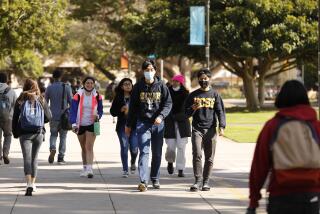UCLA, USC tied at 23rd in college rankings
Crosstown rivals UCLA and USC are tied again in the closely watched university rankings by U.S. News & World Report, despite some scoring changes that give more weight to students’ graduation rates.
UCLA and USC shared the 23rd place among best national universities, along with Carnegie Mellon and the University of Virginia, according to the magazine’s list being released Tuesday. Last year, the two Los Angeles schools were tied at 24th with Virginia.
FOR THE RECORD:
College rankings: In the Sept. 10 LATExtra section, an article about U.S. News & World Report’s college rankings omitted two schools sharing tied positions among top national universities. Emory University was tied with UC Berkeley and Georgetown for 20th, and Wake Forest University was tied for 23rd with UCLA, USC, the University of Virginia and Carnegie Mellon University. —
Officials at the magazine said their methodology this year somewhat shifted emphasis from the academic prowess of freshmen, measured by such things as high school class rankings, to how well they do in college by earning a degree. But those changes had little effect on the rankings of the top 50 national universities because they score high in graduation rates. They also have large financial endowments and resources for faculty that are important in the rankings.
The top 10 schools were the same as last year, although with some slight changes in order. Princeton was first, followed by Harvard, Yale, Columbia, Stanford, the University of Chicago; then a tie among Duke, MIT and the University of Pennsylvania; and Caltech at 10th.
UC Berkeley again was the highest-ranked public university, tied with Georgetown for 20th in the overall rating. Last year, Berkeley was 21st in a similar tie. Other UC campuses in the top 50 were: Davis and San Diego, which tied for 39th; Santa Barbara at 41st; and Irvine at 49th.
The listing has been criticized over the years for giving too much credence to schools’ wealth and selectivity in admissions. But because parents, students and school governing boards track it carefully, many colleges do everything they can to score high. Some schools have been accused of manipulating data.
Katy Murphy, who is president-elect of the National Assn. for College Admission Counseling and heads the counseling department at Bellarmine College Preparatory high school in San Jose, said many parents rely too heavily on the magazine and other college rankings because they want “outside validation of quality.” She urged families to look more deeply to find “what fits for them.”
The methodology this year slightly reduced the points for how hard it is to gain admission and shifted those to measures of retaining and graduating students, according to Robert Morse, who heads the “best colleges” lists for U.S. News & World Report. Because fewer high schools are reporting students’ class rankings, the magazine also cut the importance of that and increased the weight of incoming freshmen scores on SAT or ACT exams.
Schools below the top 50 in their category tended to be most affected, Morse said. Among them was Pitzer College in Claremont, which jumped from sharing the 43rd spot last year to 35th now in the list of national liberal arts schools. Williams, Amherst and Swarthmore topped that list, followed by a tie among Pomona College in Claremont, Bowdoin and Middlebury. Other Claremont consortium schools did well in that grouping: Claremont McKenna shared ninth place with Davidson and Haverford; Harvey Mudd was 16th; and Scripps was 25th.
Last year, a former admissions official at Claremont McKenna confessed to exaggerating statistics about admitted students. Claremont McKenna had ranked ninth in the liberal arts category and held on to that spot even after an investigation and removal of the hyped data, and then it was 10th, tied with Vassar, in last September’s overall listing.
The magazine’s changes echo a bit of what the Obama administration has proposed on a more sweeping, more populist manner. By 2015, President Obama wants an evaluation of colleges that includes such factors as average tuition, share of low-income students and effectiveness in ensuring that students graduate without too much debt.
U.S. News’ move is “a small step in the right direction but not nearly enough,” said Clare McCann, an education analyst for the New America Foundation, a Washington, D.C., think tank. The rankings still influence colleges “to act in ways that are not in the best interest of students,” such as spending more money, which might drive up tuition, she said.
As for the Los Angeles rivalry: before last year’s tie, USC twice in a row had scored slightly higher than UCLA. That reversed a long-term pattern in which the Westwood school had previously bested USC.
More to Read
Sign up for Essential California
The most important California stories and recommendations in your inbox every morning.
You may occasionally receive promotional content from the Los Angeles Times.










